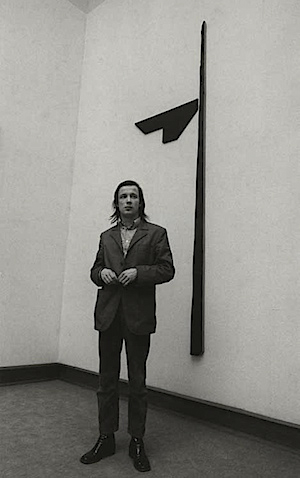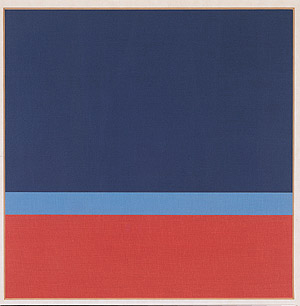Blinky Palermo: Retrospective 1964-1977
(Image: Detail from Blinky Palermo’s “To the People of New York City (Part IX),” from the Dia Art Foundation’s permanent collection, courtesy Florian Holzher/Dia Art Foundation.)
The Hirshhorn will host the first U.S. retrospective of work by noted postwar abstract painter Blinky Palermo (German, b. Leipzig, 1943; d. Maldives, 1977) from Feb. 24 through May 15. Although the artist’s reputation is well established in Europe and he has influenced generations of American artists, his work has rarely been shown in North America.

Blinky Palermo, Blaue Scheibe und Stab (Blue Disk and Staff), 1968, private collection, courtesy Hauser & Wirth
“Like Yves Klein, Blinky Palermo received critical acclaim in Europe for his contribution to the development of 20th-century art,” said Kerry Brougher, the Hirshhorn’s deputy director and chief curator. “Yet despite the fact that Palermo lived in the United States for several years and engaged with the work of American abstract artists such as Brice Marden, Agnes Martin and Robert Ryman, he has not received due recognition here. The Hirshhorn is delighted to be a part of this national tour, which gives the American public a comprehensive picture of Palermo’s achievement.”
Palermo investigated and challenged the fundamentals of painting throughout his brief yet prolific career—he died suddenly at age 33—questioning not only its conventional materials and traditional format and structure but its very definition. His practice is notable for his steadfast commitment to the medium during a period and in a context in which it was widely contested as a viable art form. He was known for engaging with the work of both European and American abstract painters as well as for his openness to the ideas and techniques of other artists, including his teacher, Joseph Beuys, fellow students Sigmar Polke and Gerhard Richter, diverse predecessors like Marcel Broodthaers, Daniel Buren, Kasimir Malevich and Barnett Newman, as well as American contemporaries Marden, Martin and Ryman. “Blinky Palermo: Retrospective 1964-1977” presents 70 works, many of which have never before been on view in North America. The pieces are installed in roughly chronological order, providing an in-depth examination of the evolution of Palermo’s aesthetic, and include examples from all of his major series: “Objects” (1964–74), Stoffbilder [Cloth Pictures] (1966–72), documentation of site-specific wall drawings and paintings (1968–73) and examples of his late Metallbilder [Metal Pictures] (1974–76).
Shortly after joining Beuys’ class at the Kunstakademie Düsseldorf in 1964, Palermo began making what he termed “Objects”: painted entities, often using found materials, that take on quasi-sculptural properties. In each of these works, the interaction between the piece and the space in which it is installed is integral to the viewer’s experience of it. Begun in mid-1966, the Stoffbilder constitute a second distinctive body of work. These disarmingly radical pieces, some monochromatic and others comprising multiple hues, are made from lengths of fabric purchased in department stores. They reveal him to be a gifted colorist and a singular successor to artists such as Henri Matisse and Mark Rothko. In his installation work, the artist engaged with specific sites making wall paintings and drawings that engaged the architectural context, animating its spaces. These concurrent modes more or less came to an end in 1973 when Palermo relocated to Manhattan, where he set up a studio that he would maintain for the remainder of his life. Here, he began to create multipartite painted compositions on aluminum panels that were anchored slightly off the wall to enhance the works’ vivid palette. Palermo’s signature series of acrylic paintings on metal culminated in his most monumental work, “To the People of New York City” (1976).
Palermo was born Peter Schwarze in 1943 in Leipzig, where he and his twin brother, Michael, were raised by an adoptive family with the name Heisterkamp. In 1962, Palermo entered the Kunstakademie Düsseldorf. In 1964, he adopted the moniker Blinky Palermo, the name of the American boxing manager and Mafioso, whom he supposedly resembled. While Heisterkamp’s decision to change his identity likely had multiple causes, it reflects his fascination with American culture, which at that time included a particular interest in Beat literature and Abstract Expressionist painting. He visited the United States for the first time in 1970 and died in 1977 while traveling in the Maldives. Though short-lived, Palermo’s career continues to influence a variety of artists working today. Exhibition curator Lynne Cooke said, “Although Palermo’s work may not be well known to American audiences at large, he is nonetheless an ‘artists’ artist,’ admired by generations of artists of many different persuasions, from Zoe Leonard to Sharon Lockhart, David Reed to Josiah McElheny, Julian Schnabel and Liliana Porter—a tribute to the extraordinary range of possibilities his innovative practice has opened up.”
Related Programs
On Feb. 24 at 7 p.m., Cooke leads a walk-through in the galleries.
On May 3 at 7 p.m., Suzanne Hudson discusses Palermo’s time in America and the context for his work here.
On May 12 at 7 p.m., the museum presents a Meet the Artist program with New York-based artist and filmmaker Julian Schnabel, who discusses recent projects in light of his formative influences, among them his friendship with Palermo, whom he met in New York in 1974.
On May 13 at 7 p.m., a film screening features Schnabel’s work.
Posted: 28 January 2011
- Categories:





